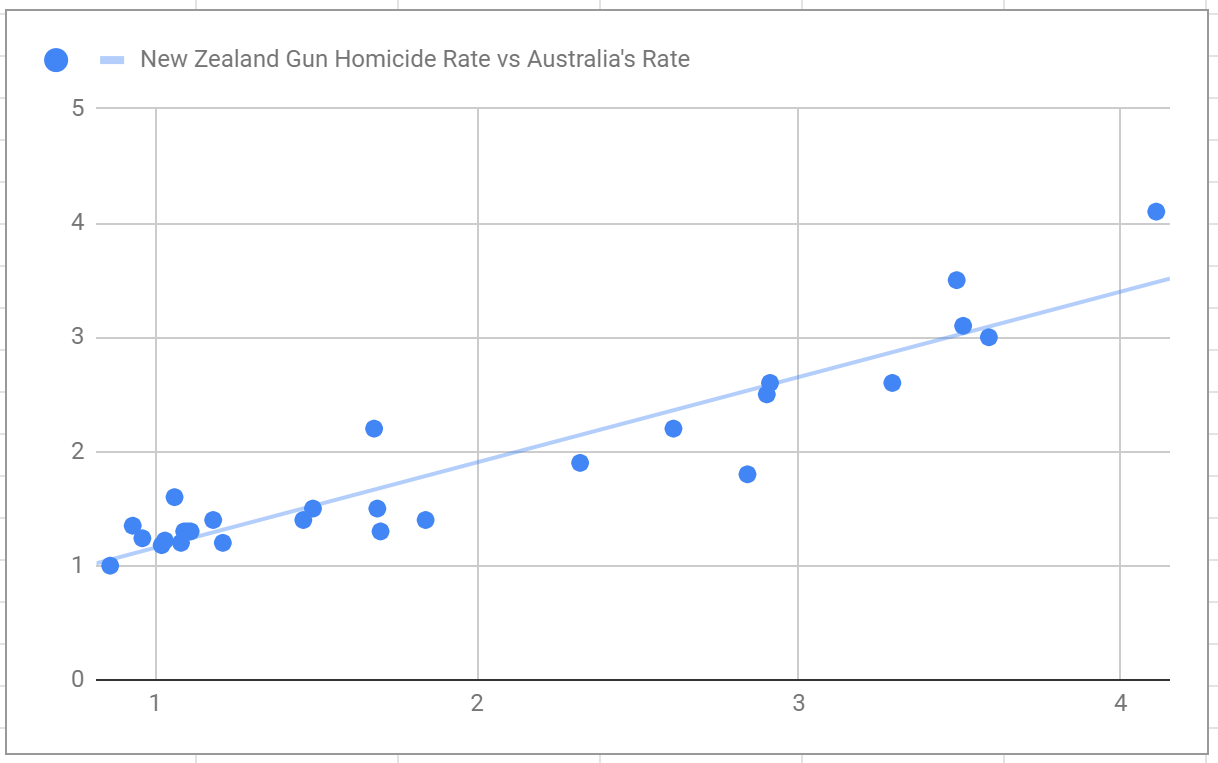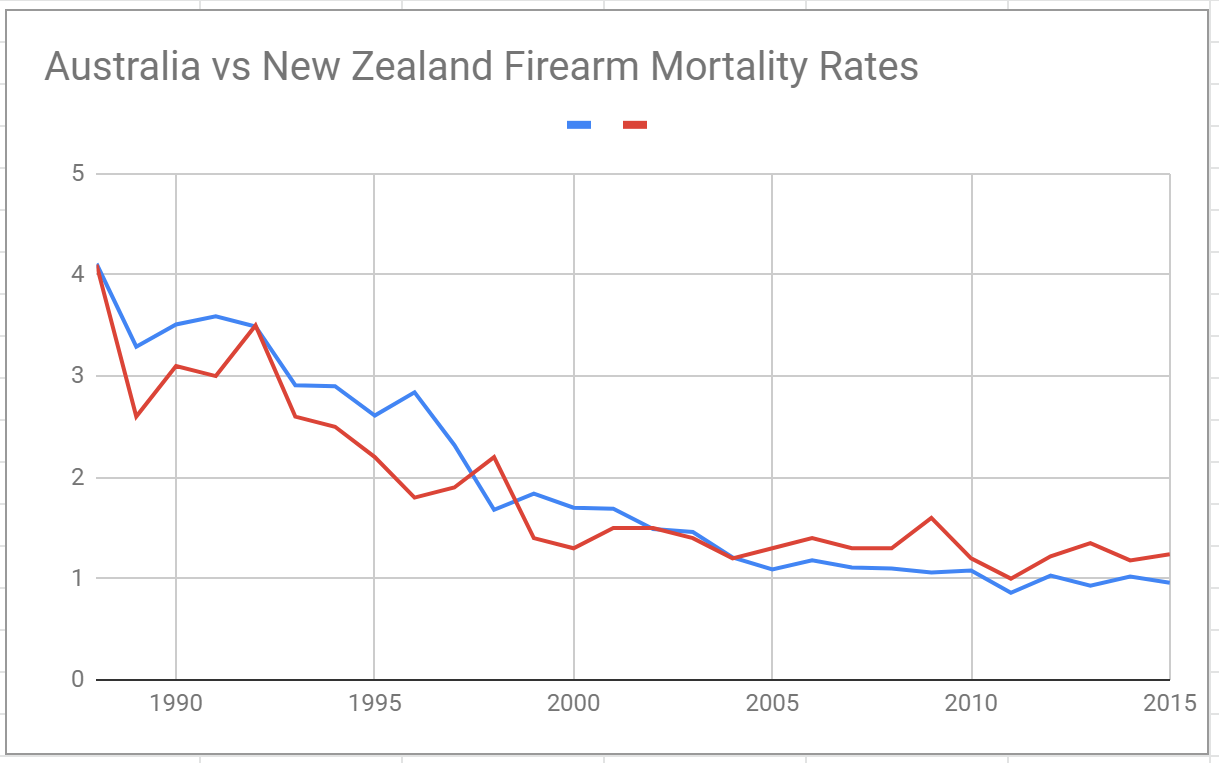What happened in New Zealand is tragic. It’s always incredibly sad when people lose their lives to disease. And let’s not kid ourselves, violence is a disease. But for a long time Australia specifically has been touted as a measure of success for gun control. And even New Zealand has relatively strict gun control laws, which require sponsorship and interviews in order to obtain a license.
But now an Australian has perpetrated a massive shooting in New Zealand, and the nation is shocked. But I’m honestly not surprised. There were a number of factors that provided a false sense of security, all of which equate to bad science. The first issue is assuming causation when all that could be determined was correlation. In my original article on the myth of Australia’s gun control success, I mentioned that gun related fatalities had declined considerably before the implementation of its gun control legislation.
The second factor involved was a failure to recognize the mathematics of rare events. Mass shootings are rare events. How rare depends on a number of parameters. Rare events are difficult to analyze, because they happen so infrequently. In this case, the gap in mass shootings in New Zealand and Australia may have been due to the rarity of the type of event, rather than legislation.
Consider another example. Suppose we have occasional flooding in a region. Maybe the region experiences a flood, once every five years, on average. Now suppose that a bunch of people think that they can just ban floods. So they implement a law preventing these large scale floods, and there’s no flood for ten years! Can we say that the legislation worked?
Mathematics can help is decide, if we recognize what’s happening. The type of process discussed here is a type of Poisson process, and with a few assumptions we can calculate the probability of n such floods happening in a given amount of time.

λ is the rate at which the process occurs, so in this case 1/5years and t must be in the same time units. So in this case, we want to know the probability of the event happening 0 times in ten years. I won’t show the calculation, but the final result is that the probability is 13.5%, which is fairly small, but not really all that unusual. Even if the legislation did nothing to change the rate at which flooding happened, there’d still be a 13.5% chance that over 10 years, there wouldn’t be a single flood.
Mass shootings are sporadic. They occur, on average, every so often, but they are fairly rare events. And even in the United States, they account for only a small fraction of violent deaths, even though America does have a gun violence problem. So in a region where mass shootings are even rarer, it’s hard to get an idea of whether there’s been a decline, unless we’re tracking a very long period of time.
The false sense of security and success in Australia and New Zealand have led researchers to ignore other issues. Going back to my original article on the myth of Australia’s success, I explained that the decline in gun related violence follows a logistic trend, starting with a slow decline, followed by a rapid decline, and then another slow decline. This kind of pattern is not indicative of a paradigm shift, but rather a change in social dynamic. Epidemiologists might recognize this pattern as the same kind of pattern that we see in SIR models. And that similarly makes sense. The flow of ideas across a social network is very similar to the spread of a pathogen.
The final issue is that people are too obsessed with guns. While gun violence is bad, and mass shootings are bad, all violent deaths are bad. Indeed, all deaths from disease are bad, and I do consider gun violence a disease. Our goal should be improving overall health of society, and that requires analyzing gun violence and other forms of violence using proper epidemiological methodologies.
But New Zealand doesn’t have as strong a gun control system as Australia!
It’s true. But the process is still quite involved. It requires passing a test, being sponsored, and going through an interview. There are also a number of firearm restrictions, including magazine restrictions. But there’s another interesting point here. New Zealand and Australia are both fairly isolated, and so we should be able to see how gun control laws impact each nation without worrying about how neighboring regions affect the influx of firearms.
I’m not great at producing extremely pretty graphs, but I’m good at identifying patterns and testing the validity of claims. Under the above assumptions, we shouldn’t expect New Zealand and Australia’s gun fatality rates to coincide, because the laws in the two nations are different and they’re not in direct contact, making black market shipments difficult. And yet, they do correlate, wonderfully in fact.

The correlation coefficient for this fit is 0.874 so it does seem like our guess on the linearity of the relationship isn’t necessarily unreasonable. I state my point this way because the goal is to try to be wrong. That’s how science works. When we can’t figure out how we’re wrong, that’s where we stop for a while, but I digress (What is Science).
Moving on to the next chart, the blue curve indicates Australia’s gun mortality rate and the red curve indicates New Zealand’s. Once again we see that the trend began prior to 1996, and it did so in both countries, and both trends match pretty damn well.

So it seems that in Australia and New Zealand, what we need to understand is what changed to reduce the rate of such violence. To simply claim that the law did it is unreasonable. It doesn’t explain the trend prior to 1996 nor does it explain why the trend matches in both nations, even though they had differing gun legislation. And so long as researchers focus on the false sense of security provided by gun control efforts, we won’t know. And if we don’t know what changed, we won’t know if it’s changing back, or how to stop it from doing so.
